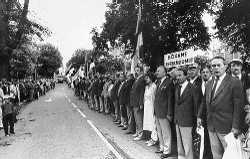 |
Vol 1, No 9, 23 August 1999
|
|
|
 T H E A M B E R C O A S T:
T H E A M B E R C O A S T:
Ten Years After Mel Huang As post-Communist Central European countries celebrate "ten years after," the Baltic states look back with their own nostalgic reminiscence. In 1989, as those in Czechoslovakia, Poland and elsewhere were being liberated, Soviet rule still prevailed on the Baltic coast. However, it was in August of 1989 that an event of monumental significance occurred - one which put Estonia, Latvia and Lithuania onto the final road toward renewed independence. The event was the "Baltic Way" human chain, held on 23 August 1989. The "Baltic Way" human chain was a joint protest action by the popular fronts in each of the countries. On the 50th anniversary of the signing of the Molotov-Ribbentrop Pact, some one million Balts linked hands and created one of the longest human chains in history, linking Vilnius to Riga to Tallinn (a route of some 600 km). This unprecedented protest action against Soviet rule brought the national liberation movements into the spotlight, setting an irreversible course for the three captive nations. The Molotov-Ribbentrop Pact and its secret protocols sealed the fate of many countries in Europe. Romania lost its Bessarabia region, Poland suffered through another partition and the "four" Baltic states (Estonia, Finland, Latvia, Lithuania) faced invasion by the Red Army. Finland managed to preserve its independence with loss of some international manoeuvrability and territory during the Winter War, which saw many Estonians and some Latvians fighting alongside their Finnish brethren against the Red Army. However, Estonia, Latvia and Lithuania's fate was sealed by the secret Nazi-Soviet agreement, which soon led to their occupation and illegal annexation by the USSR. Thus a protest against that very event was tantamount to a declaration of renewed independence. The protestors knew that most European countries and large powers - including the United States, Great Britain, France and China - never acknowledged the illegal annexation of the Baltic states. Exiled diplomats from all three countries maintained their diplomatic activities at the UN in New York, Washington, Rome, London and elsewhere. By publicly attacking the mechanism that led to that illegal annexation, the Baltic peoples made it clear to Moscow that there would be no returning to the status quo. The protest grew partly out of the publication of the texts of the secret pact in 1988 - which infuriated locals and Moscow alike, though for different reasons. The protests grew louder and the reprisals stronger. By 1990, all three countries had declared some form of autonomy - a sign of transition towards restored independence. Economic blockades occurred, fuel embargoes in the winter, raids by OMON troops leading to casualties and counter-protests by the local Russian Communists under the banner of Interfront organisations. A mere eight years ago, on 20 August 1991, following the botched putsch attempt in Moscow, the three countries declared the immediate restoration of independence. Iceland, the brave small nation that understood well the experience of foreign domination and military occupation, quickly recognised the three countries both de jure and de facto - giving Moscow little room to manoeuvre. Eventually, even Moscow acknowledged the independence of the Baltics. But only after nearly the entire world had re-recognised the three Baltic countries did the United States, led by the misguided foreign policy of George Bush, do the same. Despite his predecessor Ronald Reagan's urging and a near fist-fight in the Oval Office between two cabinet members, Bush went against US norms and displayed a weak backbone. Looking back at the events of ten years ago, the human chain was perhaps the biggest watershed for the region. It solidified the three nations' desires to restore their independence, and - through the protest action - announced it to the world - especially to Moscow. The event put Estonia, Latvia and Lithuania squarely onto the road to restored independence and there would be no going back. In many ways, this 1989 event was as significant as the Velvet Revolution or the fall of the Berlin Wall. Mel Huang, 18 August 1999
|
|
![]()
Copyright (c) 1999 - Central Europe Review and Internet servis, a.s.
All Rights
Reserved